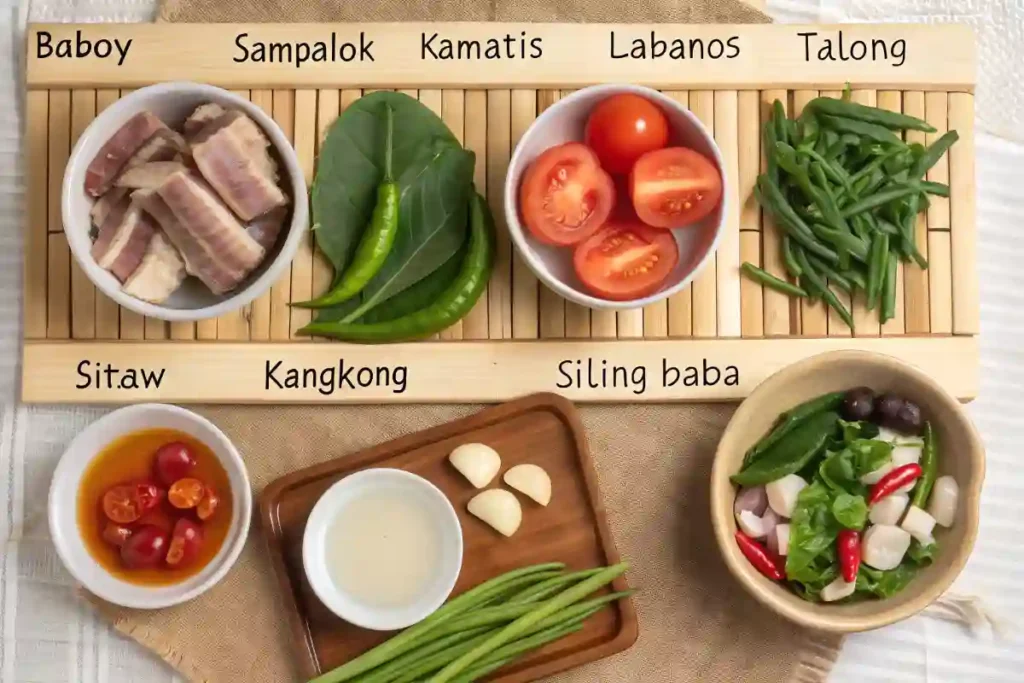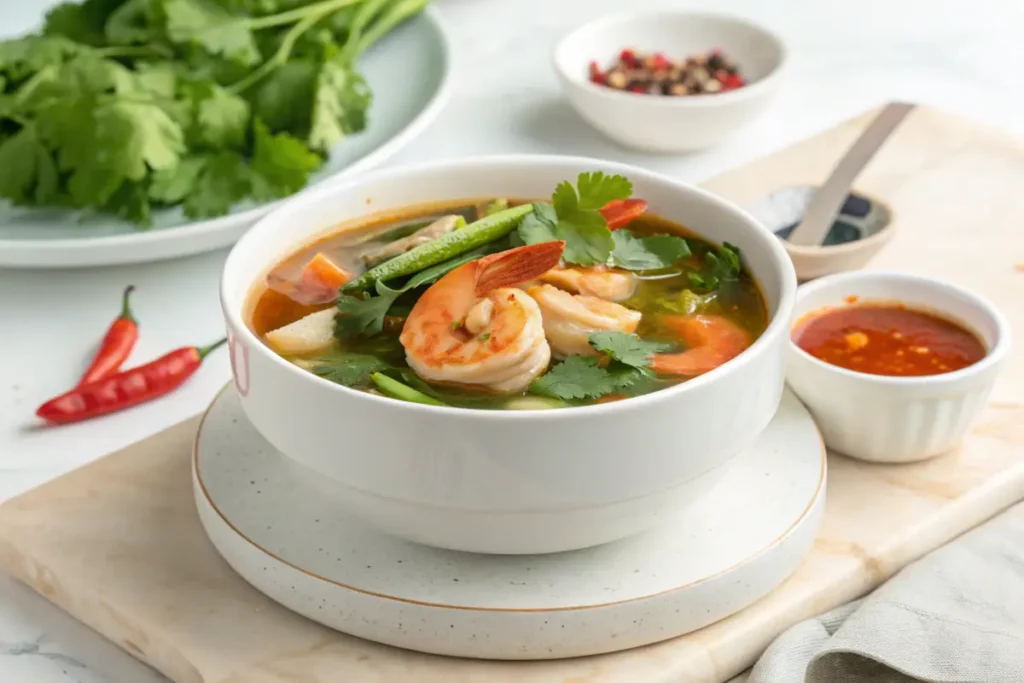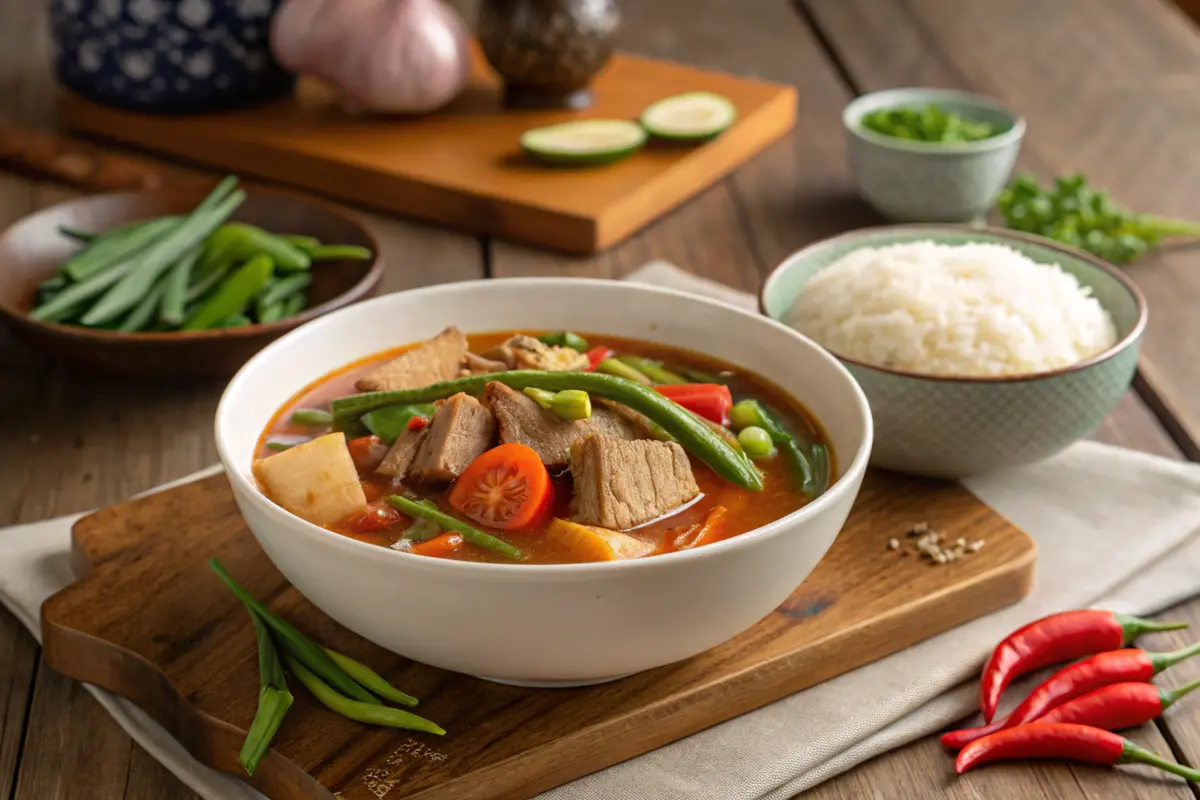If there’s one dish that perfectly embodies Filipino comfort food, it’s sinigang. This sour soup, with its medley of tender meats, fresh vegetables, and tangy broth, has become a household favorite in the Philippines and beyond. In this comprehensive guide, we’ll explore everything there is to know about the beloved sinigang recipe, from its history and ingredients to step-by-step cooking techniques and expert tips. Whether you’re a novice or a seasoned chef, this article will help you master the art of making this flavorful dish.
Introduction to Sinigang
What is Sinigang?
Sinigang is a traditional Filipino sour soup renowned for its bold, tangy flavors. Its unique taste comes from souring agents like tamarind (sampalok), kamias (bilimbi), or green mangoes. A versatile dish, sinigang can be prepared with pork, shrimp, fish, beef, or even chicken. The soup is enriched with vegetables like eggplant, string beans, and water spinach, creating a hearty and nutritious meal.
This dish isn’t just about its ingredients—it’s a cultural symbol, connecting Filipinos across generations. From family dinners to festive gatherings, sinigang offers a comforting, nostalgic experience that transcends its humble origins.
Why Sinigang is a Filipino Classic?
Sinigang’s enduring popularity stems from its ability to adapt. Every region, family, or cook seems to have their own spin on the recipe, adding a personal touch. Beyond its delicious flavor, it reflects Filipino culinary ingenuity—simple ingredients turned into a masterpiece.
This soup is also highly seasonal. During rainy days, a piping hot bowl of sinigang na baboy (pork sinigang) becomes the ultimate comfort food. In contrast, the lighter sinigang na hipon (shrimp sinigang) is perfect for warmer days, offering a refreshing, tangy bite.
Variants of Sinigang Across the Philippines
While sinigang na baboy is the most common version, other regional and ingredient-based variants abound:
- Sinigang na Hipon: Features succulent shrimp and light broth.
- Sinigang sa Miso: A fish-based sinigang with the added depth of fermented soybean paste.
- Sinigang na Baka: Uses beef, offering a richer, heartier flavor.
- Modern Twists: Some even experiment with pineapple or lechon (roasted pork), adding unique twists to the classic dish.
Ingredients for Sinigang

Main Ingredients
The beauty of a sinigang recipe lies in its versatility, and the choice of protein sets the tone for the dish. While pork belly is the most popular choice, alternative proteins like beef shank, shrimp, or milkfish (bangus) are equally delightful. The fat content in pork belly creates a rich broth, whereas shrimp or fish results in a lighter, more delicate flavor. The protein is the star, supported by the tangy broth and fresh vegetables.
Vegetables in Sinigang
A quintessential sinigang recipe wouldn’t be complete without a colorful medley of vegetables. The staples include:
- Eggplant: Absorbs the sour broth beautifully.
- String Beans: Adds a subtle crunch.
- Daikon Radish: Provides a mild, earthy flavor.
- Water Spinach (Kangkong): Brings vibrant greenery.
Feel free to add or substitute with vegetables like okra or bok choy, depending on availability and taste preferences.
The Role of Souring Agents
The soul of sinigang is its tangy broth, achieved through souring agents like:
- Tamarind (Sampalok): The traditional choice for an authentic flavor.
- Kamias (Bilimbi): A tropical alternative with a sharper tang.
- Green Mango: A fruity twist with a tart finish.
For convenience, sinigang mix packets offer an instant burst of tanginess, though nothing beats the depth of freshly prepared souring agents. The sourness can be adjusted to your liking, ensuring each bowl is uniquely yours.
Step-by-Step Guide to Cooking Sinigang

Preparing the Souring Agent
If you’re opting for fresh tamarind, the first step is extracting its essence. Boil tamarind pods in water until soft, then strain the liquid to separate the pulp. This tamarind broth serves as the base for the soup. Alternatively, dissolve sinigang mix in hot water for a quicker option.
Cooking the Protein
Start by boiling your chosen meat in water, adding onion and tomatoes to infuse the broth with flavor. For tender pork belly, simmer for at least an hour. If using shrimp, add it later in the cooking process to prevent overcooking. Remember, the key to a great sinigang recipe is allowing the protein to meld seamlessly with the sour broth.
Layering the Vegetables
Not all vegetables require the same cooking time, so add them in stages:
- Daikon and Eggplant: These take longer to cook and should go in first.
- String Beans and Okra: Add these midway to retain their crunch.
- Water Spinach: Stir in last to preserve its vibrant green color and delicate texture.
Seasoning and Finishing Touches
Once all the ingredients are cooked, season the broth with fish sauce (patis) and a dash of ground pepper. Taste the soup and adjust the sourness or saltiness as needed. Serve hot, alongside steamed rice, and a small saucer of fish sauce with chili for dipping—a classic accompaniment that enhances the dish’s flavors.
Tips and Tricks for Perfect Sinigang
Choosing the Right Meat Cut
When it comes to crafting a mouthwatering sinigang recipe, the quality of the meat is crucial. For pork sinigang, pork belly is ideal due to its balance of fat and lean meat, which enriches the broth. Cuts like spare ribs or pork shoulder are also excellent choices, offering tenderness and flavor. If you’re exploring seafood variants, shrimp with shells intact helps enhance the broth, while beef shank brings a hearty twist to the dish.
Cooking Hacks for Busy People
Short on time? A pressure cooker or instant pot can transform your cooking experience. Start by sautéing onions and tomatoes using the sauté mode. Add your pork, water, and tamarind mix, and set it to pressure cook for about 20-30 minutes. Finish by layering in vegetables, letting the residual heat cook them gently. This approach saves time while preserving the flavors.
For an even faster alternative, substitute fresh tamarind with sinigang mix, which delivers a quick burst of tangy goodness without compromising too much on taste.
Flavor Enhancements and Personal Twists
To elevate your sinigang recipe, try experimenting with modern twists. Add pineapple chunks for a hint of sweetness or toss in a few dried chili peppers for a subtle heat. You can even garnish with fresh herbs like cilantro or green onions for added aroma and depth.
For more hearty soups and stews, explore this recipe collection for ideas on how to create comfort foods with bold flavors.
Popular Sinigang Variants

Sinigang na Baboy (Pork Sinigang)
The classic sinigang na baboy remains a staple in Filipino households. Known for its rich, sour broth and tender pork, this version pairs wonderfully with steamed rice and a side of fish sauce with chili. The key is to simmer the pork until it’s melt-in-your-mouth tender, allowing the flavors to infuse every bite.
Sinigang na Hipon (Shrimp Sinigang)
For a lighter option, sinigang na hipon is a seafood lover’s dream. The shrimp imparts a delicate sweetness to the broth, balancing the tanginess perfectly. This version is quick to prepare, making it ideal for busy weeknights or spontaneous cravings.
Sinigang sa Miso (Fish Sinigang)
Adding miso paste to the traditional recipe creates a creamy, umami-packed broth that elevates the dish. Milkfish (bangus) or salmon are popular choices for this variant, making it a favorite for those seeking a richer flavor profile.
Modern Twists: Sinigang Inasal
Blending Filipino favorites, sinigang inasal marries the smoky, char-grilled taste of inasal (grilled chicken) with the tangy soup base of sinigang. This creative variant is a testament to the dish’s versatility and the endless possibilities of Filipino cuisine.
For more delicious recipes, check out this collection of creative twists to inspire your next meal adventure.
Nutritional Benefits of Sinigang
Low-Calorie and High-Nutrient Dish
One of the many reasons to love a sinigang recipe is its incredible nutritional value. Packed with fresh vegetables like kangkong (water spinach), eggplant, and string beans, this dish delivers a hearty dose of vitamins and minerals. These vegetables provide essential nutrients like vitamin A, vitamin C, and fiber, which support your immune system and digestive health.
What’s more, the broth is typically low in calories, making sinigang a guilt-free comfort food. By choosing lean protein options like shrimp or fish, you can create a dish that’s both satisfying and waistline-friendly.
Role of Vegetables in Nutrition
The mix of vegetables in sinigang isn’t just for flavor—it’s also for nutrition. Daikon radish, for instance, is a great source of antioxidants, while okra contains soluble fiber that promotes heart health. Even the souring agents like tamarind and green mango bring additional benefits, including antioxidants and a boost to digestion.
Heart-Healthy and Immune-Boosting Properties
Using ingredients like fish sauce in moderation ensures the dish remains heart-healthy. When cooked with fish or shrimp, sinigang also offers omega-3 fatty acids, which are known to improve cardiovascular health. The warm, sour broth is soothing and helps boost your immune system, making it an excellent meal during flu season.
Sinigang as a Cultural Staple
History and Origins of Sinigang
Sinigang has a long and storied history in Filipino cuisine, and its origins highlight the country’s resourcefulness. The dish’s name comes from the Tagalog word sigang, which means “to stew.” Traditionally, families would gather fresh ingredients from their gardens or local markets to make this tangy, comforting soup. The dish’s flexibility and accessibility made it a staple across different regions of the Philippines.
Over time, this humble dish has evolved, incorporating influences from other cuisines while staying true to its roots. Whether made with pork, shrimp, or fish, sinigang remains a culinary expression of Filipino identity.
Why Sinigang is Loved Globally
In recent years, the sinigang recipe has gained international recognition, with food critics and travelers praising its unique flavor profile. In fact, TasteAtlas named sinigang the best vegetable soup in the world, cementing its place on the global stage.
Its appeal lies in its ability to strike a balance between sour, savory, and refreshing flavors. For many, it’s a nostalgic dish that reminds them of home. For newcomers, it’s an exciting introduction to Filipino food culture. Whether served at family gatherings or upscale restaurants, sinigang continues to captivate hearts and palates worldwide.
FAQs About Sinigang
What Makes Sinigang Taste Sour?
The signature tangy taste of a sinigang recipe comes from souring agents like tamarind, kamias (bilimbi), and even green mangoes. These natural ingredients are boiled and strained to extract their sour essence, forming the base of the broth. For those short on time, instant sinigang mix provides a convenient alternative, ensuring that every bowl delivers the same mouth-puckering delight.
Can I Substitute Tamarind with Other Ingredients?
Absolutely! If tamarind isn’t available, you can use substitutes like lemon juice, vinegar, or even pineapple to achieve a similar sour flavor. While these options may alter the taste slightly, they maintain the spirit of the dish and allow for creative experimentation in your sinigang recipe.
What Side Dishes Go Well with Sinigang?
Absolutely! If tamarind isn’t available, you can use substitutes like lemon juice, vinegar, or even pineapple to achieve a similar sour flavor. While these options may alter the taste slightly, they maintain the spirit of the dish and allow for creative experimentation in your sinigang recipe.
Is Sinigang the National Dish of the Philippines?
While many consider sinigang the unofficial national dish, it shares the spotlight with adobo, another Filipino favorite. Both dishes represent the diversity and ingenuity of Filipino cuisine, but sinigang holds a special place in the hearts of many for its comforting, homey appeal.
Conclusion
Why You Should Try Making Sinigang at Home
Crafting a sinigang recipe at home is more than just cooking—it’s an experience that connects you to Filipino culture and tradition. The dish’s simplicity and versatility make it accessible for beginners, while its rich flavors ensure it satisfies even the most seasoned palates. Whether you’re preparing it with pork, shrimp, or a unique twist, sinigang always delivers a memorable meal.
Final Tips for First-Time Cooks
If you’re new to making sinigang, start with the basics. Use readily available ingredients like pork belly, tamarind mix, and a medley of fresh vegetables. Remember to taste and adjust the sourness and seasoning to suit your preferences. Don’t be afraid to get creative—add your own spin with alternative proteins or unique garnishes.
For a comforting, hearty meal that brings people together, sinigang is a must-try dish. Its harmonious blend of tangy, savory, and refreshing flavors makes it an instant crowd-pleaser, perfect for any occasion. So, grab your pot, gather your ingredients, and dive into the delicious world of sinigang today!

